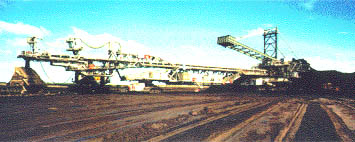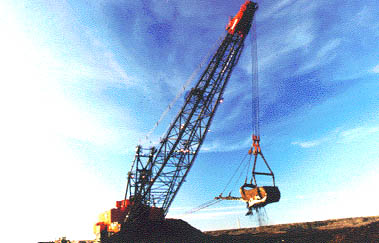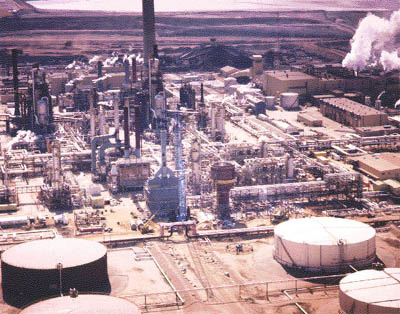Canada's Oil Sands Shifting to Second Generation Reclaimation, Mammoth Machines Being Retired
 Contents
Contents- Mining at Syncrude
Mechanical monsters from Mad Max or perhaps Star Wars? No, they are the enormous machines devised to literally move mountains: gigantic draglines the height of 25-story buildings with buckets the size of two-car garages, and 2,800-ton, bucketwheel reclaimers 105-ft tall and longer than football fields, that lumber along on 44-foot diameter crawler wheels scooping up oil sands at a rate of 6,150 tons per hr.

For more than 20 years, these behemoths have crept across the northern Alberta landscape clawing out a crater comparable to those on the Moon as they harvest crude oil from one of the largest oil sands deposits on this planet, but now they are beginning a phased retirement as new technology replaces them.
Mining at Syncrude (back to top)
Syncrude has been extracting oil from these oil sands, located at Mildred Lake near Ft McMurry, Alberta, Canada since the company's startup in 1978. A joint venture owned by AEC Oil Sands, AEC Oil Sands, Athabasca Oil Sands Investments, Canadian Occidental Petroleum Ltd., Canadian Oil Sands Investments, Gulf Canada Resources Limited, Imperial Oil Resources, Mocal Energy Ltd., Murphy Oil Company Ltd., and Petro-Canada, the company has grown to four trains of dragline, bucketwheel reclaimers, and conveyor systems, one in each quadrant of the open-pit mine.
Extracted by draglines and piled in windrows along the sides of the surface mine, the oil sands are collected by the bucketwheel reclaimers by digging it from the windrows and placing it on the conveyor systems, where it is transported to the dump pocket and fed to the extraction plant. Approximately 70% of oil sand production is completed by this method, although this proportion will drop to around 50% with the retirement of the units located in the east side of the base mine.

Oil sand from the East Mine is being replaced by two production trains at the North Mine. Additional production will come from the first train of Aurora, when it starts up in July 2000. Both North and Aurora will use large heavy hauler trucks and shovels to replace the draglines and bucketwheels and hydrotransport to replace the conveying systems.
A milestone on Syncrude's conversion to high-tech truck and shovel mining occurred Thursday, March 11, when Bucketwheel Reclaimer No. 2 was decommissioned. It had been in continuous use since its start-up at Mildred Lake in 1978.
"We're witnessing the passing of an era with the retirement of the first piece of first-generation oil sands equipment," Jim Carter, president and chief operating officer, said at a retirement ceremony beside the huge machine. "While we applaud the long and productive life of our bucketwheels, and say goodbye with a twinge of nostalgia, we also look forward to being a part of the continuing evolution of the oil sands business, and the complete transition to truck-and-shovel mining."
Bucketwheel No. 2 was the first of the four owned by Syncrude to reclaim over a million tons in a single week. This occurred in November 1995, but during its entire operating life, No. 2 reclaimed a total of over 460 million tons of oil sand.

No. 2 was located at the East Mine, where oil sand production is being replaced by the more modern North Mine's truck and shovel equipment and hydrotransport system. Thus next to retire was Bucketwheel Reclaimer No. 2's partner, Dragline 2, which was decommissioned this summer. Another dragline and bucketwheel train will retire in the first quarter of 2000.
Bucketwheel Reclaimer Facts (back to top)
The Bucketwheel Reclaimers are amazing equipment. No. 2 was designed and constructed by Krupp and O & K of Germany, firms with extensive experience with reclaimers and excavators. Four were designed exclusively for operation on the Syncrude site and were erected at Mildred Lake in 1977 and 1978 by Bechtel Canada.
No. 2 began production in the third quarter of 1978 and reclaimed 220 million bank cubic meters during its operating life. To put this in perspective, the total volumes excavated for the Panama Canal were 232 million bank cubic meters, which is close to the volume reclaimed by Syncrude's Bucketwheel Reclaimer No. 2.
Syncrude Bucketwheel Reclaimers:
- Length: 462 ft or 120 meters (longer than a football field)
- Wheel Diameter: 44 ft or 13 meters
- Height: mast is 105 ft or 30 meters above ground
- Buckets: 14 with a capacity of 3.1 cubic yards or 2.4 cubic meters
- Powerplant: 12,000 horsepower
- Replacement Cost: $34 million
- Design Operating Weight: 1,840 tons (of which paint alone is over 10 tons)
- Actual Operating Weight: approximately 2,800 tons due to modifications and oil sand encrustation. Syncrude has consistently made modifications to the equipment over the years to improve the production capability and reliability.
- Average Production Rate: 6,150 tons per hour
- Annual Production Rate: 30 million tons
- Speed: 30 ft per minute , or 9 meters per minute, on seven crawlers
- Crew: one operator with the front digging head and main crawlers, one operator controlling the discharge and rear crawlers, and one oiler/relief.
- Amenities: With the adoption of 12-hr shifts, a redundant hydraulic room aboard was converted into a lunchroom equipped with a conventional kitchen, coffee pot, microwave and refrigerator.
Dragline No. 2, Discovery (back to top)
The height of a 25-story building with a bucket the size of a two-car garage, Dragline No. 2, "Discovery," was designed and constructed by Bucyrus-Erie and has been in continuous use with Syncrude since August 1977. Assembly of the massive dragline took 18 months and 375,000 person-hrs. (Two of Syncrude's draglines were from bucyrus-Erie and two were from Marion.) Known as a "walking dragline," Discovery could make a giant step every 40 seconds when time came to move its location in the mine.
During its lifetime, Discovery worked over 105,000 operating hrs and mined over 312 million bank cubic meters (624 million tons) of oil sand at the East Mine—a third more material than was moved for the construction of the Panama Canal. It also walked 1,100 km within the Syncrude mine site, which required over a half-million steps to be made.
Syncrude Dragline Facts:
- Manufacturers: Bucyrus-Erie BE 2570 or Marion 8750
- Replacement Cost: $75 million
- Assembly: 18 months and 375,000 person-hrs
- Boom Length: 360 ft or 110 meters
- Bucket Size: 61 cubic meters (80 cubic yards) and 68 cubic meters (89 cubic yards)—roughly the size of a two-car garage
- Boom Operating Radius: 340 ft or 104 meters
- Power: The draglines are electrically powered and fed by a 25 kV trailing cable which is stepped down by on-board transformers to supply the multitude of electric motors which power the drag, hoist, swing and propel functions. The equivalent power of the electric motors is about 28,000 horsepower.
- Operating Weight: 6,200 tons
- Average Production Rate: 6,500 tons per hr
- Annual Production Rate: 18 million bank cubic meters (36 million tons)
- Speed: nine ft per minute or three meters per minute
- Walking Method: 80-ft-long steel shoes located on the side of dragline lift the front end of the circular tub forming the base of the dragline. With each step, the tub slides forward. Between steps the tub rests on the ground, waiting to be lifted again by the shoes.
- Crew: Three—operator, oiler, and groundsperson.
- Crew Functions: The operator is largely concerned with the 60-sec dig and dump cycle and mining strategy. The oiler oversees the automatic lubrication system and the motor control house as well as other mechanical parts. The groundsperson operates a Caterpillar D-11 (one of the world's largest) to prepare the mine surface behind the dragline as well as a rubber-tired tractor equipped with both a cable hoop, to relocate the trailing cable (a 25 kV extension cord), and a hydraulic hammer for working on the bucket wear components. A typical crewmember is trained in all three positions and the crew rotate positions during the course of an operating shift to maintain peak production.
- Amenities: Paneled walls, comfortable seats, radios, cellular telephones, air conditioning, full galley and lunchroom equipped with a conventional kitchen, coffee maker, water cooler, microwave and refrigerator.
